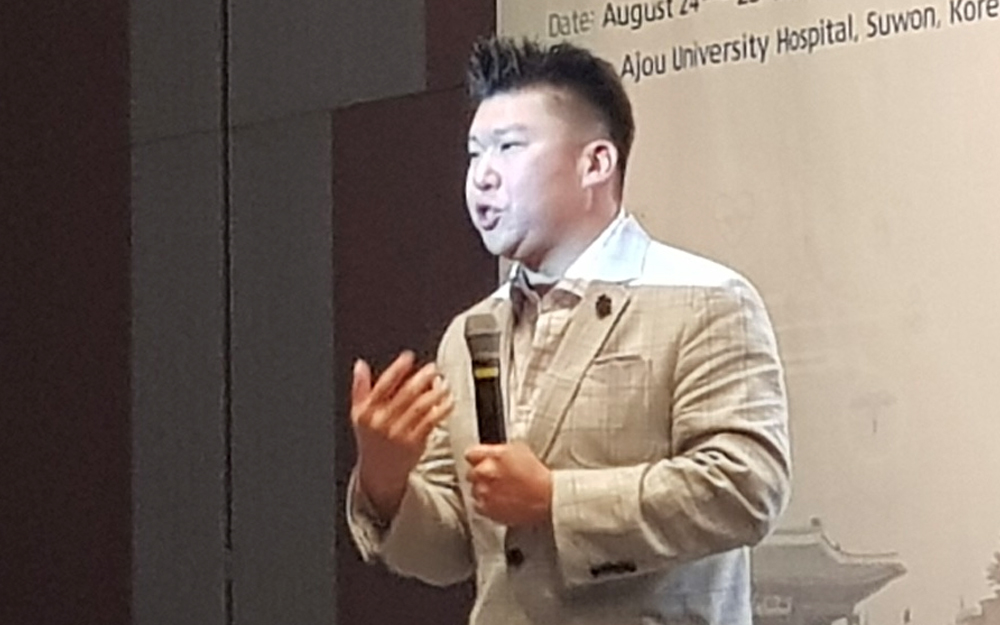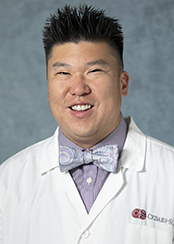Cedars-Sinai Blog
Faces of Cedars-Sinai: Dr. Kenneth Kim
Dec 07, 2020 Cedars-Sinai Staff

Kenneth H. Kim, MD, MHPE presenting at the ASGO (Asian Society of Gynecologic Oncology) conference.

Meet Dr. Kenneth Kim, the new director of Gynecologic Oncology at Cedars-Sinai!
As a former art major and tennis pro, Dr. Kenneth Kim always knew he wanted to do something with his hands. So, he traded the paintbrush and racquet for the scalpel to pursue a career in gynecologic oncology. At Cedars-Sinai, Dr. Kim brings his expertise and unparalleled experience and leadership in the field to his new role as director of the Division of Gynecologic Oncology, the Board of Governors Endowed Chair in Gynecologic Oncology, and chair of the Committee on Advisement of Training and Education (COATE).
"My goal is always to guide the team so everyone understands the 'why' and the 'how' behind what we're doing. Like in patient care, it's about investing in people and putting them first."
We spoke with him to learn more about his journey to Cedars-Sinai and his plans for the future.
How did you find your passion for gynecologic oncology?
Dr. Kenneth Kim: Medical school gave me the opportunity to explore several specialties, and I learned that the field of gynecologic oncology is the only one where I would be trained as both a surgical and medical oncologist. It allows me to see patients from diagnosis through surgery, chemotherapy, immunotherapy and more. We are a "one-stop shop" for our patients! I think this greatly improves their experience and allows for the best possible continuity of care.
What led you to Cedars-Sinai?
KK: Cedars-Sinai was one of the first medical centers in the nation to offer a subspecialty training program in our field. Our fellowship started here in 1971—the year gynecologic oncology became recognized as a board-certified specialty.
So, in many ways, Cedars-Sinai has been a pioneer in this area, with a long legacy of training leaders who go on to make significant contributions to the field. But that wasn't the only reason I wanted to come here: Probably most of all, it was also the people. When I met with the current faculty—whom I now call my colleagues—I immediately saw that they are not just excellent, patient-centered surgeons, they are also really good people.
When and why should patients see a gynecologic oncologist?
KK: There is increasing data that suggests patients who have cancer or are at a high risk of developing cancer should see a gynecologic oncologist for the best possible outcomes. A gynecologic oncologist can craft a comprehensive care plan, ensuring patients avoid shuffling between specialists or having multiple procedures.
Coming to a center of excellence such as Cedars-Sinai for cancer care can actually impact survival and outcome. We work very closely with primary care and other specialty physicians to make sure gynecologic cancer is identified as early as possible and that information and ideas are shared openly and often throughout the course of a patient's care plan.
What is your top priority for your division?
KK: Our division currently performs the most gynecologic cancer surgical cases in the state of California and is among the top five in the nation in terms of volume. My goal is to continue to increase the clinical trials we offer along with the number of patients we treat so we can provide an even higher level of care. We want to be known for both our clinical expertise and our research innovation. This type of expansion would also bring increased training opportunities.
What are the new treatments or research studies underway that get you excited?
KK: There are a number of clinical trials on the horizon. One I am really excited about is a study we hope will improve the way we test and screen for HPV. We're evaluating a self-collection home test, which would help identify HPV earlier for those with limited access to care. On the surgical side, we are leaders in minimally invasive procedures and have also invested a lot in state-of-the-art robotic systems that allow us to improve our technique and lead to better, faster recoveries for our patients.
Your role also includes leadership of the Committee on Advisement of Training and Education. What is your philosophy when it comes to education?
KK: I have never really thought of education as simply education. In medicine, learning and taking care of patients is a team sport. On every team, there are people with varying levels of skill and experience who need mentoring—no matter their level. My goal is always to guide the team so everyone understands the 'why' and the 'how' behind what we're doing. Like in patient care, it's about investing in people and putting them first.
How do you envision the future of gynecologic oncology?
KK: In the last couple of years we've seen numerous advancements that have improved patient outcomes, especially when it comes to ovarian cancer. Major steps forward in targeted therapies and immunotherapies—such as immunotherapy and the use of PARP inhibitors—have impacted the way we treat patients.
Genetic testing and tumor sequencing have also come a long way. We can test patients and assess their risk or pinpoint the best method of treatment based on their genetic and molecular makeup. More and more—when appropriate—we're also offering these tests to patients as well as their families, allowing for early detection that sometimes prevents cancer altogether. I'm looking forward to even more significant breakthroughs in the coming years.



